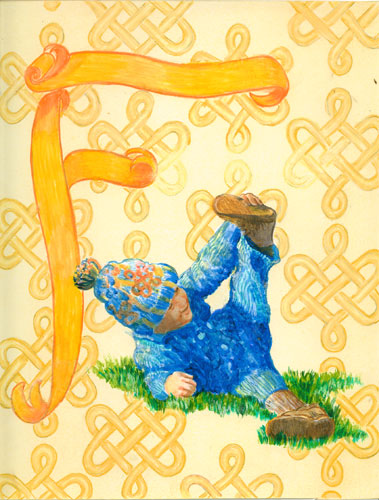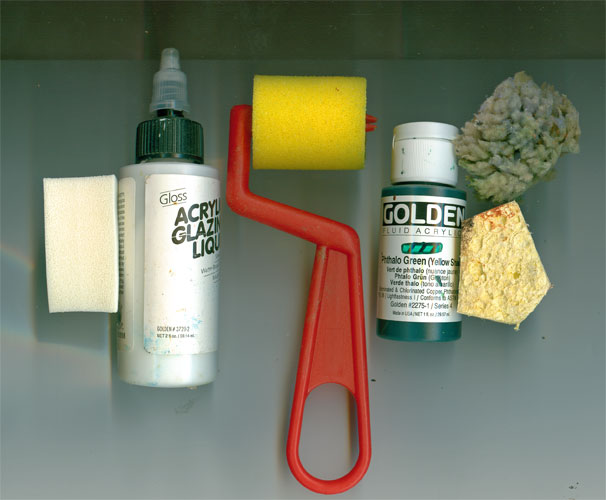 |
I've been asked about my technique of sponge brush painting as it applies to "fine art" painting. I developed my technique to accomplish a certain look for some illustrations I was working on.....but sponge brush painting can easily work in many "fine art" situations as well.
My initial problem was to get nice smooth graduations in a monochromatic background for a page in an alphabet book. I'd come up with the concept to paint designs as a kind of "wallpaper" background with the main image, text and large alphabet letter going on top.I wasn't using any computer graphics for this particular book, I don't use an airbrush, and I was working in acrylics....not known for their ease of getting a smooth graduation in colours. I was aiming for something like this:
 |
I had been studying the work of a 20th century illustrator Maxfield Parrish, and found that he tackled the problem of smooth backgrounds with glazes "pounced" with a large soft brush. Since he worked in oils (i.e. a time before acrylics), he used linseed oil as his glaze medium, and layers took foreeeeever to dry. I am lucky to be living with acrylics, so I could update the technique for my illustrations. I also didn't like the look of pounced glazes....still too many marks in the paint surface.
I hit upon the idea of using sponge brushes after looking at a home dec magazine, and reading about faux finishes. AHA! here was the way to get my smooth colour graduations without any visible brush marks. I bought a collection of different sponges....all the way from sea sponges (which have beautiful textures, when that's what you want) to roller sponges from the paint store to makeup facial sponges sold to apply makeup.
 |
I went thru my paints and found a sample of Golden (brand name) Glazing liquid and I had numerous bottles of Golden fluid acrylics. Fluid acrylics have the same pigment load as regular paints, but are cut with more clear acrylic so they are the consistency of cream as opposed to regular paints which are more like toothpaste. I found that if I puddled a bit of the glazing liquid on my palette then dropped in a drop of fluid acrylics and mixed with a knife.....I got a lovely looking glaze, that would be accepted readily by the sponge.
I was working on 3 ply bristol board at the time. I ran the sponge brush over the entire board and let it dry. It bent a bit at first, but with some adjustment to the liquid load....the board dried nice and flat. I could then apply another coat if I wanted to modify the colour in some way without any lifting that occurs in watercolours. As an extra added benefit, I found that the "tooth" was just perfect for coloured pencils, without the plastic effect that acrylics normally have.
I ended up with the best of all worlds. I could get my graduations without computer or an airbrush. I could also add texture just by changing the sponge brush I use. And any additional artwork I wanted to put on top would be accepted without any problems.
For landscapes more in the "fine art" mode, I found that skies would be luminous done in layers of blues and greens, just as Maxfield Parrish discovered using oils. When I wanted to fill in foliage for trees and such, I just grabbed a sea sponge and dabbed away. First using the blue base for shadows, covering with a variety of greens for the background foliage. I then (following Maxfield Parrish's technique) I would dab on pure white for highlights on leaves, which would later be glazed over with various colours as needed....i.e. oranges for fall, yellow for summer etc. I used this technique for this painting among others: It was the perfect technique for shimmering leaves and flowing water.
I've been using this technique for years now.....and I just love the results.
The best way to learn is just to mess about with paints. I usually have a "problem" I want to solve, and my experiments can usually find at least one solution. But more often just messing around with paints will lead to a whole 'nother way of painting that will open up new solutions.
If you would like to submit a Visual Art Tip, just let me know at alison@lyneart.com
return to - Lyne Art - Frank Lyne wood carvings - Alison Davis Lyne illustrations-Visual Art Tips page